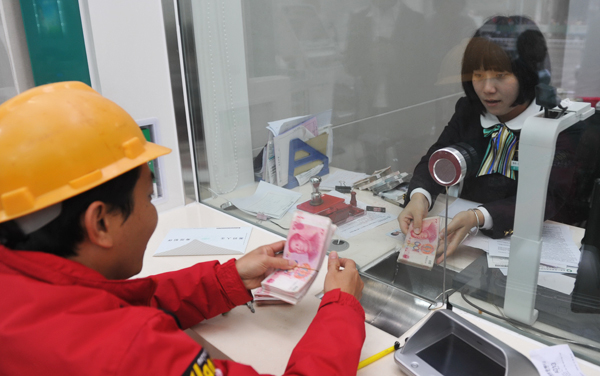NPLs to rise more slowly, no systemic risk seen
Updated: 2016-11-07 07:38
By JIANG XUEQING(China Daily)
|
||||||||
 |
|
A man counts cash at an Agricultural Bank of China branch in Qionghai, Hainan province. MENG ZHONGDE/FOR CHINA DAILY |
Liberalization of interest rates is leading to new business models emphasizing service fees
Chinese banks will continue to see a slight increase in the ratio of nonperforming loans although the rise in bad loans will not lead to systemic risk in the banking sector, analysts said.
"As China has not yet completed restructuring of the real economy, existing loans will inevitably face the pressure of credit risk," said Zeng Gang, director of banking research at the Institute of Finance and Banking under the Chinese Academy of Social Sciences.
Agricultural Bank of China Ltd recorded year-on-year growth of its NPL balance of 28.28 percent to 229.82 billion yuan ($34 billion) and its NPL ratio rose by 37 basis points to 2.39 percent as of the end of September, both numbers being the worst of the big four commercial banks. Industrial and Commercial Bank of China Limited was second, with an NPL ratio increase by 18 basis points to 1.62 percent.
Zeng said Chinese banks have sufficient loan impairment provisions and profits to bear the pressure. Bank of China Ltd and its subsidiaries, for instance, increased impairment losses on assets by 42.49 percent during the first three quarters of 2016, compared with the same period of last year.
"About 60 to 70 percent of Chinese bank loans are collateral loans, which will cause a low ratio of actual loss. With the country pushing supply-side reforms forward and the real economy getting better, banks will reach a turning point," he said.
Currently, banks are exploring new ways to handle rising NPLs. Since the beginning of this year, the four largest commercial banks have issued nonperforming asset-backed securities totaling more than 6.7 billion yuan. Besides, China's banking regulator is supporting the development of local asset management companies to enhance their ability to dispose of bad assets.
Zhang Xingrong, head of banking research at Bank of China's Institute of International Finance, said: " Bad assets disposal will benefit from the new policies to relax restrictions on local asset management companies and encourage securitization backed by nonperforming assets. We estimate that the growth of NPLs will slow down, although NPL ratios will still increase slightly year-on-year."
While NPL ratios were on the rise during the first nine months of 2016, the "Big Four" banks continued to post slim growth of net profit attributable to equity holders of the bank, ranging from 0.46 to 2.48 percent.
"The profit growth of most Chinese banks has fallen to single digits and will even turn negative, truly reflecting the current state of the real economy," said Zeng of the CASS.
China's interest rate liberalization led to the shrinking of net interest margins, and the restructuring of the real economy made it difficult for banks to continue relying on credit for income growth. At the same time, banks increased loan impairment provisions to deal with rising NPLs. A combination of all these factors triggered a slowdown in profit growth for banks.
"To improve their profits, banks will make stronger efforts to increase intermediary business income by developing investment banking, wealth management, bank card services and asset custody," he said.
During the first three quarters of 2016, Bank of China and its subsidiaries saw a 28.1 percent year-on-year growth of non-interest income to 140.47 billion yuan, representing almost 38 percent of the total operating income. The other three largest commercial banks also posted increases of non-interest income or net fee and commission income.
Zhang said banks will look for a new engine of profit growth in the Belt and Road Initiative, emerging industries, renminbi internationalization and personal financial services.
- Summit of Climate Conscience kicks off in Morocco
- British Airways announces special fares for New Year
- S. Korean president says to accept investigation over scandal if necessary
- Names of twin panda cubs born in Austrian zoo revealed
- May's Brexit plans thrown into chaos by landmark court ruling
- Syrian army announces 'humanitarian pause' on Friday

 Ten photos from around China: Oct 28- Nov 3
Ten photos from around China: Oct 28- Nov 3
 Shanghai Art Fair connects people with art in daily life
Shanghai Art Fair connects people with art in daily life
 Chinese captain takes off at Air Show China in Zhuhai
Chinese captain takes off at Air Show China in Zhuhai
 Wuzhen Internet Intl Conference Center under preparation for 3rd WIC
Wuzhen Internet Intl Conference Center under preparation for 3rd WIC
 China's top 10 post-80s self-made billionaires
China's top 10 post-80s self-made billionaires
 Famous paintings recreated with chocolate
Famous paintings recreated with chocolate
 Looking for a ride?
Looking for a ride?
 Robots draw people to China International Industry Fair
Robots draw people to China International Industry Fair
Most Viewed
Editor's Picks

|

|

|

|

|

|
Today's Top News
US election rhetoric unlikely to foreshadow future US-China relations
'Zero Hunger Run' held in Rome
Trump outlines anti-terror plan, proposing extreme vetting for immigrants
Phelps puts spotlight on cupping
US launches airstrikes against IS targets in Libya's Sirte
Ministry slams US-Korean THAAD deployment
Two police officers shot at protest in Dallas
Abe's blame game reveals his policies failing to get results
US Weekly

|

|







